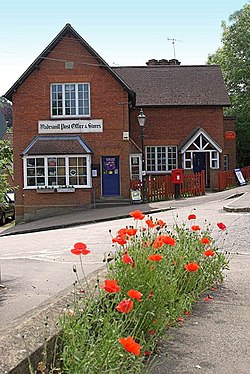Wadesmill
| Wadesmill | |
| Hertfordshire | |
|---|---|
 Thundridge (adjoining Wadesmill) former Post Office and village shop which served both villages until closure | |
| Location | |
| Location: | 51°50’20"N, 0°1’48"W |
| Data | |
| Local Government | |
Wadesmill is a hamlet in Hertfordshire, located on the north side of the River Rib with an estimated population of 264. Running through the centre of Wadesmill is the Old North Road, the old London to Cambridge road, now superseded by the A10. Since the A10 has been redirected to bypass the village, Wadesmill and surrounding villages have returned to the quiet of former times. The route that was formerly the A10 is an ancient one with portions of it following the line of the Roman Road Ermine Street. Ermine street also figures as the former main street in Wadesmill's adjacent village Thundridge.
History
Historically Wadesmill is particularly notable for two things. Firstly it is the location of the first turnpike road in the United Kingdom (and therefore the first in the world). Secondly the Clarkson Memorial halfway up nearby High Cross hill, stands here; a memorial to Thomas Clarkson's rest point in his travels at which moment he decided to devote much of the rest of his life to ending the slave trade.
The Wadesmill Turnpike was created by Act of Parliament ("The Turnpike Act") in 1663 as a result of serious deterioration of the "Old North Road" due to travel by laden barley wagons supplying the brewing trade in the nearby maltings town of Ware. As with most government-imposed taxations however, routes to circumvent the turnpike were quickly established, resulting in one instance in the increased use of what became known as "The Great North Road" - the A1.
To the east of Wadesmill is the picturesque estate of Youngsbury, some history and description of which is admirably described elsewhere:
- Youngsbury consists of an 18th-century park and woodland with 4 hectares of garden around the house, the front part of which is dated 1745, the back early 19th century, with 18th-century stables. There are extensive 16th to 18th-century walled kitchen gardens, an arboretum, an icehouse and tumuli and Roman barrows within the grounds, which extend to the river Rib. Capability Brown's involvement included widening the river and creating two islands, designing a ha ha and placing small groups of trees in open parkland. Nineteenth-century development of the kitchen garden was re-created in the late 20th century, with notable mixed borders. There is a moat and church in a bend of the river on the southern edge of the parkland.<ref>Hertfordshire County Council - Youngsmill
Capability Brown is actually said to have reviewed the rolling parkland surrounding Youngsbury house and observed that he need do nothing to improve upon what nature had already achieved.
The moat and church referred to are in fact Thundridge Bury and Thundridge old church, neither of which are still standing in entirety.
Outside links
